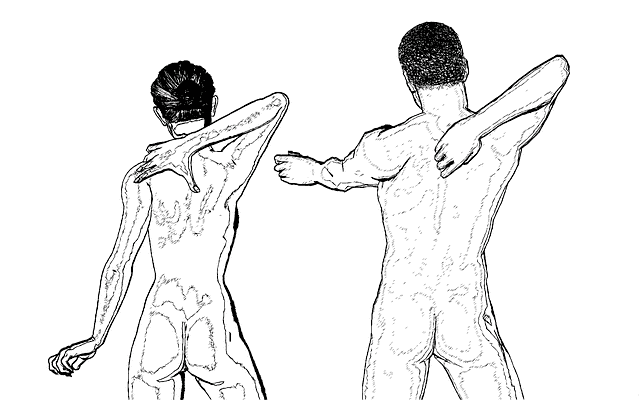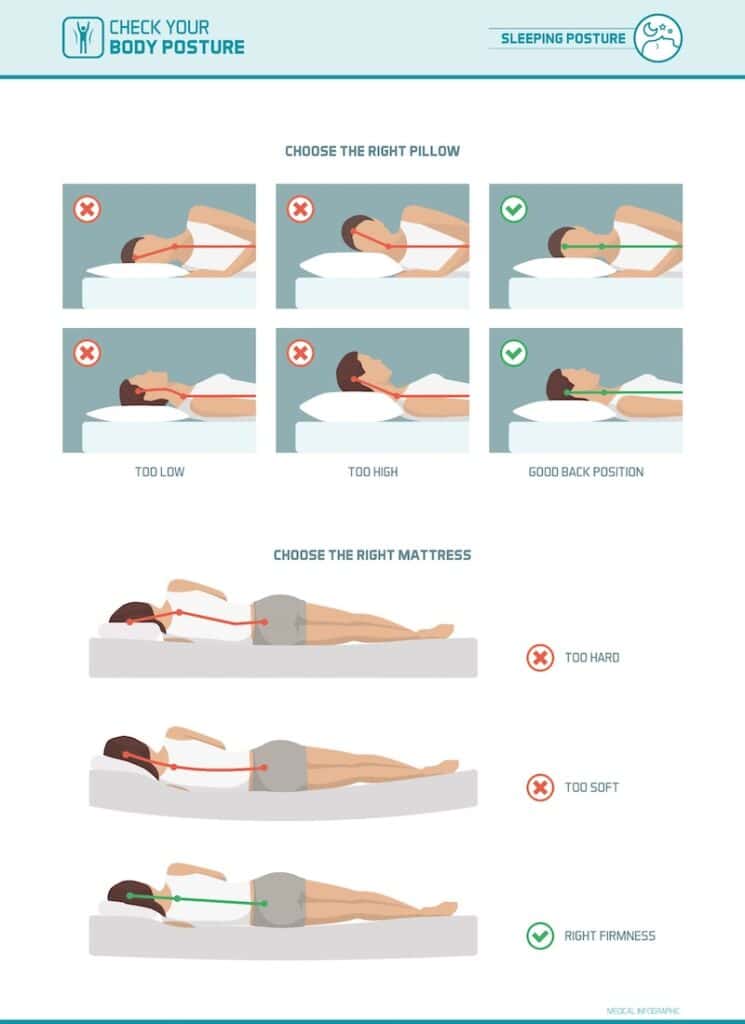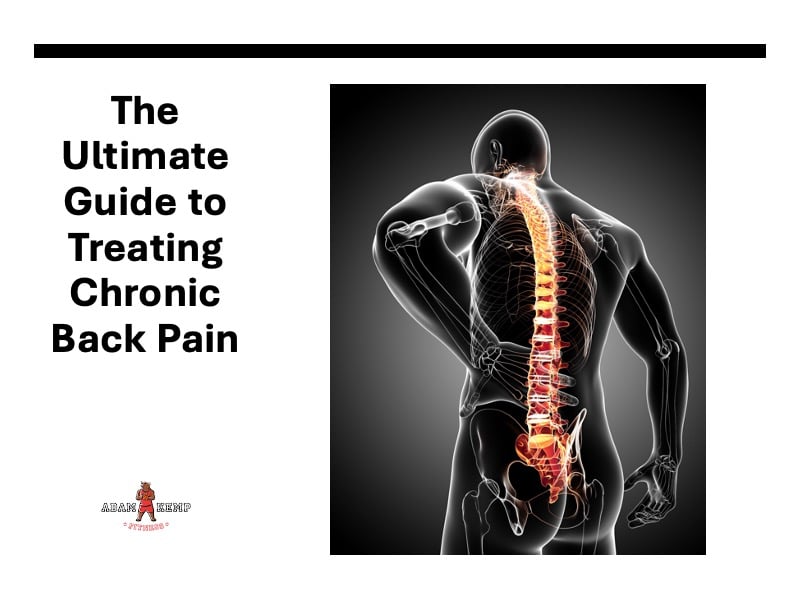How to Treat Chronic Back Pain – The Ultimate DIY Guide
Chronic back pain affects millions worldwide, limiting mobility, reducing quality of life, and leading to psychological stress.
Research indicates that nearly 80% of adults experience back pain at some point in their lives, with chronic pain being the leading cause of disability worldwide (Hoy et al., 2014).
While medical interventions can be effective, adopting natural, holistic approaches can empower you to manage pain effectively.
I love to write about back pain because, after suffering a PARS fracture in 2017 and rehabbing my injury, I returned to professional basketball at 100% strength, learning valuable tips along the way that I’m confident will help others manage their pain as well.
With over a decade of experience as a professional athlete and extensive knowledge in nutrition and fitness, I’ve learned firsthand the importance of natural strategies for managing chronic pain.
This guide provides evidence-based strategies, exercises, natural remedies, and lifestyle changes that can help you alleviate chronic back pain and regain your active life.
Understanding Chronic Back Pain
Chronic back pain is often the result of poor posture, a sedentary lifestyle, injuries, or degenerative changes in the spine. Interestingly, one of the fundamental causes of back pain stems from our evolution to walking on two feet.
This upright posture, while critical to human mobility and functionality, places a unique strain on our spine and musculoskeletal system, contributing to back pain when our muscles and joints aren’t adequately supported.
The key to managing chronic back
pain lies in direct physical training focused on improving strength and mobility, combined with a consistent approach to maintaining physical activity, proper ergonomics, and a healthy lifestyle.
There are several tips and tricks to reduce chronic back pain, the primary way to get rid of back pain is through improved mobility and better movement patterns.
How to Treat Chronic Back Pain

Effectively treating chronic back pain often requires a multifaceted approach, blending lifestyle changes, targeted exercises, and natural remedies.
By addressing the root causes of pain and incorporating consistent physical activity, you can significantly reduce discomfort and improve your quality of life.
The following methods provide practical, evidence-based strategies to help you manage and alleviate chronic back pain naturally.
Best Exercises for Chronic Back Pain Relief
Regular exercise is crucial for back pain management, as it improves mobility, strengthens muscles, and enhances posture. Evidence suggests that exercises like yoga, strength training, and walking can significantly reduce pain and prevent further injury.
Mobility Training
Mobility training is essential for managing low back pain, as it improves flexibility and reduces strain on the spine.
Integrating soft tissue massage and self-myofascial release techniques, like foam rolling, before mobility exercises enhances muscle quality by breaking up adhesions and improving blood flow.
This preparation allows for deeper stretching and more effective movement.
Focusing on hip mobility, core strength, glute strength, and pelvic control strengthens key areas that support the spine, reducing back pain over time.
Together, these strategies create a comprehensive approach to relieving tension and promoting long-term back health.
Strength Training
Building core and back muscle strength is essential for supporting the spine. Focus on posterior chain exercises like glute bridges, pelvic tilts, and wall sits. These movements enhance stability, improve posture, and help alleviate pressure on the spine.
Strengthening these muscle groups not only helps with immediate pain relief but also prevents future injuries by providing a solid foundation for all your daily movements.
Consistent strength training also boosts overall mobility, making it easier for your body to perform tasks without straining the lower back.
Walking and Aerobic Exercise

Low-impact exercises such as walking help build endurance without putting excessive stress on your joints and spine, making it a sustainable way to maintain back health.
Regular aerobic exercise like walking also increases blood flow to the muscles and tissues in the lower back, aiding in their healing and recovery.
Importantly, walking for weight loss is an excellent option because less weight on your body reduces stress on your back and spine, leading to a significant decrease in back pain over time.
If walking is too much for you, aqua cycling or water aerobics are also options!
Starting your day with a brisk walk on an empty stomach is an excellent way to reduce inflammation and promote weight loss, which can alleviate pressure on the lower back.
Fasted cardio boosts fat metabolism, making it a powerful strategy for managing weight and reducing back pain.
Effective Natural Products for Chronic Back Pain Relief
Natural Products for Reducing Back Pain
Natural supplements and remedies can effectively reduce inflammation and provide pain relief without the side effects of synthetic medications.
Turmeric
Turmeric is renowned for its powerful anti-inflammatory properties, making it an excellent natural remedy for managing chronic pain. The health benefits of turmeric extend beyond pain relief; it also supports joint health, boosts the immune system, and aids in reducing inflammation throughout the body, promoting overall wellness.
Studies show that turmeric’s active ingredient, curcumin, reduces arthritis symptoms and chronic pain, so incorporating a turmeric supplement like NatureWise Turmeric and Ginger for its potent anti-inflammatory effects can help reduce back pain.
Essential Oils
Using essential oils for back pain is a natural way to find relief and reduce inflammation.
Essential oils like peppermint, lavender, and wintergreen are particularly effective, with peppermint oil’s menthol providing a cooling sensation that soothes sore muscles. Lavender oil offers both anti-inflammatory and analgesic properties, making it ideal for calming sore muscles and easing tension.
Frankincense oil, known for its powerful anti-inflammatory effects, is also highly effective when applied topically to treat back pain and promote healing.
CBD Oil
CBD oil is another natural remedy that has gained popularity for its ability to manage chronic pain without psychoactive effects. CBD can provide more effective pain relief than conventional analgesics without the side effects associated with long-term NSAID use, and I have had a lot of success with topical CBD products for pain. T
My favorite topical is the Raw Botanics Raw Relief Hemp & Adaptogen Roll On.
These products deliver fast, targeted relief and, in my experience, outperform standard options like IcyHot or other store-bought topicals in terms of both effectiveness and long-lasting pain reduction.
If you’re wondering, “How long does it take CBD to work for pain?”, the answer can vary depending on the product and your body’s response, but topical CBD products often provide noticeable relief within minutes when applied directly to areas of discomfort.
Anti-Inflammatory Diet for Chronic Back Pain Relief
An anti-inflammatory diet can be a powerful tool in managing chronic back pain by reducing systemic inflammation that contributes to discomfort and stiffness. By focusing on nutrient-dense whole foods that are rich in antioxidants and omega-3 fatty acids, this type of diet not only targets inflammation at its source but also supports overall health and cellular repair.
Consistently following an anti-inflammatory diet can improve energy levels, reduce pain, and promote faster recovery from physical activities.
Foods to Include
- Leafy Greens: Kale, spinach, and broccoli are packed with antioxidants, vitamins, and minerals that combat inflammation. These leafy greens are also high in fiber, which supports gut health—a crucial component in reducing inflammation throughout the body.
- Fruits: Berries (such as blueberries, strawberries, and raspberries) and citrus fruits are loaded with vitamin C and flavonoids, which help neutralize free radicals and reduce oxidative stress in the body. Their high antioxidant content also aids in repairing damaged cells that contribute to chronic pain.
- Healthy Fats: Olive oil, avocado, and nuts like almonds and walnuts provide essential fatty acids that have anti-inflammatory properties. Olive oil, in particular, contains oleocanthal, a compound with similar effects to NSAIDs in reducing inflammation.
- Fatty Fish: Salmon, tuna, mackerel, and sardines are rich in omega-3 fatty acids, particularly EPA and DHA, which are well-known for their ability to decrease inflammation and reduce the production of inflammatory chemicals in the body. Consuming these fish regularly can significantly lower inflammation markers, supporting overall joint and back health.
Foods to Avoid
- Processed Foods: Foods that are high in trans fats, artificial ingredients, and preservatives, such as fried foods, packaged snacks, and fast food, can trigger and worsen inflammation. These ingredients can also lead to increased oxidative stress and disrupt the body’s natural healing processes.
- Refined Sugars and Grains: Items like white bread, pastries, sodas, and sugary cereals can cause spikes in blood sugar, leading to increased levels of inflammatory proteins in the body. High sugar intake has also been linked to elevated levels of cytokines, which play a key role in promoting inflammation and exacerbating chronic pain conditions. Reducing or eliminating these foods from your diet can help stabilize blood sugar levels and lower overall inflammation.
Adopting an anti-inflammatory diet not only addresses the root causes of back pain but also enhances overall well-being by supporting immune function, heart health, and metabolic processes.
By making these simple dietary adjustments, you can create a significant impact on your body’s ability to manage chronic back pain naturally.
Sleeping Tips to Relieve Back Pain

Optimizing your sleeping position and choosing the right mattress are crucial factors in effectively managing back pain. Sleeping on your stomach is generally not recommended, as it can put excessive pressure on the spine, leading to misalignment and increased discomfort.
For optimal support, try sleeping on your back with a pillow placed under your knees to maintain the natural curve of your spine.
Alternatively, sleeping on your side with a pillow between your knees can help keep your spine aligned and reduce strain on your lower back, promoting better rest and less pain upon waking.
Therapy Options for Chronic Back Pain

While home remedies and lifestyle changes are effective, some therapies can further enhance pain relief and spinal health.
Physical Therapy
Physical therapy is often the most effective option for eliminating chronic back pain at its root cause.
Unlike other treatment methods that primarily address symptoms, physical therapy focuses on correcting the underlying issues in your body’s movement patterns that contribute to pain.
A qualified physical therapist can assess your posture, muscle imbalances, and joint mechanics, creating a personalized program to improve your strength, mobility, and flexibility.
Physical therapy for seniors can be especially beneficial in addressing the postural changes and muscular imbalances that often contribute to chronic back pain.
By retraining your body to move correctly, physical therapy not only reduces pain but also helps prevent future injuries.
Chiropractic Care
Chiropractors use spinal adjustments to improve alignment and relieve nerve pressure. Research has shown that chiropractic care is cost-effective and offers long-term benefits for chronic back pain management.
Inversion Therapy
Inversion table therapy involves hanging upside down to decompress the spine, which can help relieve pressure on spinal discs. According to research, inversion therapy can improve lumbar flexibility and reduce chronic low-back pain.
Massage Therapy
Massage therapy helps release muscle tension, improve circulation, and reduce pain. Regular sessions can lead to long-term relief by enhancing blood flow to the affected areas and reducing muscle stiffness.
If you cannot afford a massage therapy session, self-massage tools are affordable and allow you to do massage therapy at home.
Sleeping Tips to Relieve Back Pain
Proper sleeping positions and the right mattress play a significant role in managing back pain.
Avoid sleeping on your stomach, which can strain the spine. Instead, try sleeping on your back with a pillow under your knees or on your side with a pillow between your legs to maintain spinal alignment.



